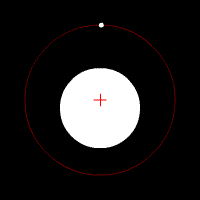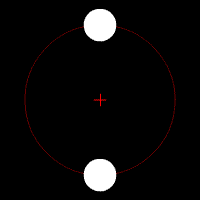Emulating a geocentric planetary system
Some published settings -- such as the Greyhawk 'verse commonly seen in conjunction with Dungeons & Dragons -- treat the prime planet's host solar system as geocentric. How could this be reconciled with what we now know about orbital mechanics and gravitation, though?
The only theories I have come up with so far are:
A heliocentric system that 'fakes' a geocentric system convincingly
In this case, Oerth (Greyhawk's prime planet) is a large-ish planet that is tidally locked to a highly luminous host star, so that one side of the planet is permanently in the broiler, and the inhabited side is dark save for what light their star gives them. What the inhabitants perceive as the star, then, is a large, highly reflective moon that orbits the planet; the remaining 'planets' to the inhabitants then become smaller moons, and they'd have a few small rocks to serve as actual moons close-in to the planet (captured asteroids, perhaps?)
This wouldn't work, though, if there were gas giants roaming around -- they'd have to orbit the true host star, which'd provide a way for the inhabitants of the prime world to detect what's really going on.
A very large planet and a very small star in a tight binary couplet
In this case, Oerth would be an enormous rockball with high gravity and inertia, and be orbiting in a tight couplet with a very dim, small star such as a red dwarf. Moons would be as normal as could be in such a deep gravity well, while the rest of the planets would be further out from the star-planetoid (brown dwarf?) binary couplet.
However, this raises two questions:
Greyhawk's published canon states that the sun there is the third object out from Oerth -- with the inner two presumably perceived as planets; they could be very small moons or captured rocks instead, though, and I suspect people wouldn't catch on, at least at first...
How do you keep the gravity of this megaplanet from turning the inhabitants into Flat Stanley?
This post was sourced from https://worldbuilding.stackexchange.com/q/4211. It is licensed under CC BY-SA 3.0.
1 answer
TimB's answer is basically what I would write, except for a very small loophole that I'll include here.
Any celestial body does not actually orbit another body, but a point in space called the system's barycenter, the center of mass. You can take a look at some of the animations here to get a good idea of what I'm talking about. In a system such as the Earth-Sun system (where one body is much smaller than another), the barycenter is inside the larger object, like here:
In a system where the objects are closer in mass (such as a pair of neutron stars), the orbits will be more like this:
Now put a small body in the center of the system (you can use this simulator, accessible directly here). Use three bodies, with two of the same mass, and put the third - the smallest - in the center. What happens to the planet?
Absolutely nothing. The forces on it are in equilibrium.
This equilibrium would not last forever - in fact, it would only last for a very short while - but in this case, the stars would revolve around the planet.
There's actually a second possibility I hadn't considered: a binary planet.
Take two very massive Hot Jupiters (let's say about 18 Jupiter masses each). put them close together (I mean really close together) and set them spinning about one another. Now take a brown dwarf1, about which the stars revolve. Perhaps it's low-mass, around 25 Jupiter masses. Have the planets go in motion around it. In the resulting system, the barycenter will be closer to the planets, meaning that, technically, the star orbits the planets! It'll be more like this system.
1 Okay, brown dwarfs aren't truly "stars", but they're close enough.























0 comment threads